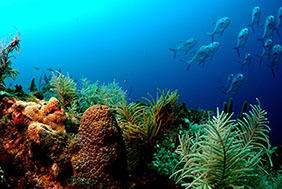Featured Archive - 2022 Publications
Below is a sampling of publications generated by NOAA's coral ecosystem activities in 2022. To access a complete list of NOAA coral ecosystem related publications, use the CoRIS Geoportal
(https://www.coris.noaa.gov/search/) search tool.
Atlantic-Caribbean coral reef ecosystems are in the midst of an unprecedented outbreak of stony coral tissue loss disease (SCTLD). Characterized by rapid spread, rapid tissue loss, and high mortality rates, SCTLD has affected corals along the entirety of Florida's Coral Reef and in 22 Caribbean countries and territories, including the U.S. Virgin Islands and Puerto Rico and the Flower Garden Banks in the Gulf of Mexico. SCTLD is rapidly reducing coral cover in a region already dealing with declining coral reefs. The disease's persistence in affected areas and continued spread represents one of the most important threats currently facing America's coral reefs.
As part of ongoing efforts, the Coral Program regularly provides a summary report on its projects, partnerships, and planning process. These activities are all geared toward implementing the Coral Program's strategic plan which aims to: Increase resilience to climate change; Reduce land-based sources of pollution; Improve fisheries' sustainability; and, Restore viable coral populations.
A new article out in February 2022 in the journal Frontiers in Marine Science describes the process of scoring the National Coral Reef Monitoring Program (NCRMP) coral reef status reports for all U.S. coral reef states and territories. By design, the reports were high-level and glossy in order to be easily understood by policy makers and the public. This new article details the technical approaches the authors took to create the scores used in the status reports.
The Socioeconomic Component of the National Coral Reef Monitoring Program (NCRMP) gathers and monitors a collection of socioeconomic data in seven U.S. coral jurisdictions. The team continued its second monitoring cycle with data collection in Hawai'i in 2020, and recently released their report of summary findings along with two new infographics. The report outlines current human dimensions information relevant to coral reef resources in Hawai'i, as well as trends between the first (2015) and second monitoring cycles, while one infographic focuses solely on the 2020 findings and the second focuses on trends. Survey results are representative of Hawai'i (further stratified by East and West), Kaua'i, Maui, and O'ahu Islands.


